Did you know about these new Pesticide Laws
 One of the hardest aspects of safety can be keeping up with the laws and requirements that are ever changing... on top of the day to day duties involved with running your business. This is where working with a Safety Training Company can help, and why here at CSTC we are not only helping our customers, but you our readers keep up to date with those changes. In this blog post, we're going to take a quick look at some of the more recent changes in PHC Pesticides, and what you have to do to stay current and compliant.
One of the hardest aspects of safety can be keeping up with the laws and requirements that are ever changing... on top of the day to day duties involved with running your business. This is where working with a Safety Training Company can help, and why here at CSTC we are not only helping our customers, but you our readers keep up to date with those changes. In this blog post, we're going to take a quick look at some of the more recent changes in PHC Pesticides, and what you have to do to stay current and compliant.
Changes regarding the Application Exclusion Zone ( AEZ )
The Application Exclusion Zone refers to the area surrounding the pesticide application equipment that must be free of all persons other than appropriately trained and equipped handlers.
-
If a person is not trained/does not have PPE they cannot be in the AEZ
- Suspend Application and make adjustment if someone comes into the AEZ
- If the distance from the ground to the point the pesticide leaves the nozzle is more than 12 inches then your AEZ is 100 feet.
- If the distance from the ground to the point the pesticide leaves the nozzle is less than 12 inches then your AEZ is 25 feet.
Decontamination Supplies
- Must provide 3 gallons of water per pesticide handler at the beginning of the day
Eye wash and Shower Stations
- Must have a station at mixing site if label/sds requires eye protection for that pesticide
Cliffnotes version of Pesticide Safety
What you need to know:
- How pesticides can enter your body.
- 4 Routes of Exposure
- Eyes
- Nose (Inhalation)
- Mouth (Ingestion)
- Skin (Dermal)
- 4 Routes of Exposure
- Use your Personal Protective Equipment!
- Different Types of PPEs (Examples)
- Eye Protection (Always in California)
- Rubber Gloves (Almost Always in California)
- Long Sleeved Shirts
- Long Pants
- Respirator (Always NIOSH Approved)
- Different Types of PPEs (Examples)
- Symptoms of Exposure to Pesticides
- Tired
- Headache
- Dizzy
- Vomit
- Blurred Vision
- First Aid for Exposure to Pesticides
- Eyes
- Rinse for 15-20 minutes
- Seek Medical Attention
- Inhalation
- Remove the Victim to Fresh Air
- Perform mouth to mouth if the victim is not breathing, and only if you’re trained
- Seek medical attention
- DO NOT go into an enclosed area without a Respirator
- Swallowed
- Dilute be giving water if label says its ok to do so
- Induce vomiting only if label says its ok to do so
- Never give anything to unconscious victim
- Call Poison Control Center at 1800222122 for additional emergency information
- Seed Medical Attention
- Skin
- Remove contaminated clothing
- Rinse with cold water for 15-20 minutes
- Wash exposed area with soap and water. Don’t press hard or scrub too hard.
- Seek Medical Attention
- Eyes
- General Information
- Wash your face and other areas of unprotected skin when:
- After working with pesticides
- Before eating
- Before smoking
- Before going home
- Before using the restroom
- Cleaning procedures for PPE
- Start by washing rubber gloves on the outside
- Wash impermeable Cap
- Wash Eye Protection
- Wash Respirator
- At the end wash gloves from the outside and then the inside
- Wash your face and other areas of unprotected skin when:
Hope this information is helpful.
For more information on PHC laws, regulations, or our class offerings, please call us and speak to one of our experts.
